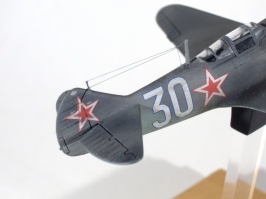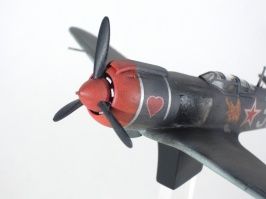Enamel paints are your answer for small details. That grille section would go smoother with an enamel wash (really diluted enamel paint). Reason being, the surface tension of the paint is so low, that it finds it's way through the model.
Enamel washes are used for:
- highlighting details like panel lines - Tamiya has a product for this exact case called Panel Liner
- creating subtle dust/dirt/mud effects
- image occlusion (shading/shadow casting)
But for your case with the grill, you could use any black enamel paint and dilute it a little, not too much to make it a wash, but just enough to lower the surface tension so that it's easier to apply.
If you make a mistake, wipe it off with white spirit.
For masking, Tamiya sells two different types of masking tapes. One is extremely fine (white), the other is normal modeler's masking tape (yellow). Cut them to size on your board and then apply them on your model. Just need to have some patience.
Now, the little scratch on your roll bar isn't that big of a deal. You can pass that off as a scuff mark, wear and tear, or grime depending on how you approach it. Some mistakes end up adding more to your build.
I'm not going to bog you down with a slew of videos to watch but here's two that will help you in some way:
For reworking:
For repair/do-over:
To repair using the chrome foil/chrome paint method, paint the part a gloss black before applying the chrome paint. You should be set after that.
Don't panic, this is your canvas, you can do whatever you want with it. If some idea didn't work out because of a mistake, then try to make the best of it, or take the project in a different direction (like you did by making it a body color instead of keeping it chrome).
You're doing great! Keep at it 👍







 👍 👍 👍
👍 👍 👍




